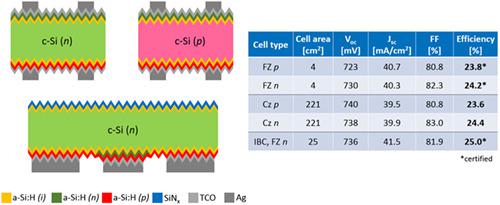当前位置:
X-MOL 学术
›
Prog. Photovoltaics
›
论文详情
Our official English website, www.x-mol.net, welcomes your feedback! (Note: you will need to create a separate account there.)
The versatility of passivating carrier‐selective silicon thin films for diverse high‐efficiency screen‐printed heterojunction‐based solar cells
Progress in Photovoltaics ( IF 6.7 ) Pub Date : 2019-12-12 , DOI: 10.1002/pip.3227 Antoine Descoeudres 1 , Jörg Horzel 1 , Bertrand Paviet‐Salomon 1 , Laurie‐Lou Senaud 1 , Gabriel Christmann 1 , Jonas Geissbühler 1 , Patrick Wyss 1 , Nicolas Badel 1 , Jan‐Willem Schüttauf 1 , Jun Zhao 1 , Christophe Allebé 1 , Antonin Faes 1 , Sylvain Nicolay 1 , Christophe Ballif 1 , Matthieu Despeisse 1
Progress in Photovoltaics ( IF 6.7 ) Pub Date : 2019-12-12 , DOI: 10.1002/pip.3227 Antoine Descoeudres 1 , Jörg Horzel 1 , Bertrand Paviet‐Salomon 1 , Laurie‐Lou Senaud 1 , Gabriel Christmann 1 , Jonas Geissbühler 1 , Patrick Wyss 1 , Nicolas Badel 1 , Jan‐Willem Schüttauf 1 , Jun Zhao 1 , Christophe Allebé 1 , Antonin Faes 1 , Sylvain Nicolay 1 , Christophe Ballif 1 , Matthieu Despeisse 1
Affiliation

|
Providing state‐of‐the‐art surface passivation and the required carrier selectivity for both contacts, hydrogenated amorphous silicon thin films are the key components of silicon heterojunction (SHJ) solar cells. After intensive optimization of these layers for standard front and back contacted (FBC) n‐type cells, high surface passivation levels were achieved on cell precursors, demonstrated by minority carrier lifetimes exceeding 18 ms on float‐zone (FZ) and 11 ms on Czochralski (Cz) c‐Si wafers. The application of these very same layers on cheaper and commercially available Cz p‐type wafers resulted in similar passivation quality, with lifetimes above 10 ms as well. Large‐area industrial bifacial FBC SHJ cells processed on wafers taken along the full length of a high‐resistivity Cz p‐type ingot showed efficiencies in the 22.5% to 23% range, significantly higher than previously reported results on such substrates and on par with their n‐type counterparts. Best efficiencies on large‐area monofacial devices (>220 cm2) are 23.6% on Cz p‐type and 24.4% on Cz n‐type, similar to certified results obtained on lab‐scale cells (4 cm2), 23.76% on FZ p‐type and 24.21% on FZ n‐type. Notably, no specific adaptation of the reference n‐type cell process was necessary to achieve these results on p‐type material. Additionally, a 25% certified efficiency has been obtained on medium‐sized (25 cm2) interdigitated back‐contacted SHJ cells, featuring the same passivation layers developed for FBC devices. These results illustrate the versatility of the SHJ technology for various high‐efficiency screen‐printed solar cell configurations and show possible ways to improve its competitiveness on the global photovoltaic market.
中文翻译:

钝化载流子选择硅薄膜对多种高效丝网印刷异质结太阳能电池的多功能性
氢化非晶硅薄膜可提供最先进的表面钝化和两个触点所需的载流子选择性,是硅异质结(SHJ)太阳能电池的关键组件。在对标准正面和背面接触(FBC)n型电池进行这些层的深入优化后,在电池前体上实现了高表面钝化水平,这表明少数载流子的寿命在浮区(FZ)上超过18 ms,在Czochralski上超过11 ms (Cz)c-Si晶片。在便宜且可商购的Cz p型晶片上使用这些非常相同的层可得到类似的钝化质量,其使用寿命也超过10毫秒。在晶片上加工的大面积工业双面FBC SHJ电池,沿高电阻率Cz的全长进行拍摄p型锭在22.5%至23%的范围内显示出效率,显著比在这种衬底上先前报道的结果更高和看齐其Ñ型对应物。大面积单面设备(> 220 cm 2)的最佳效率在Cz p型上为23.6%,在Cz n型上为24.4%,与在实验室规模的电池(4 cm 2)上获得的认证结果相近,在Cz n型上则为23.76%。 FZ p型和FZ n型的24.21%。值得注意的是,不需要参考n型细胞过程的特定适应就可以在p上获得这些结果。型材料。此外,中型(25 cm 2)叉指背接触式SHJ电池已获得25%的认证效率,其特征与为FBC设备开发的钝化层相同。这些结果说明了SHJ技术在各种高效丝网印刷太阳能电池配置中的多功能性,并显示了提高其在全球光伏市场上竞争力的可能方法。
更新日期:2019-12-12
中文翻译:

钝化载流子选择硅薄膜对多种高效丝网印刷异质结太阳能电池的多功能性
氢化非晶硅薄膜可提供最先进的表面钝化和两个触点所需的载流子选择性,是硅异质结(SHJ)太阳能电池的关键组件。在对标准正面和背面接触(FBC)n型电池进行这些层的深入优化后,在电池前体上实现了高表面钝化水平,这表明少数载流子的寿命在浮区(FZ)上超过18 ms,在Czochralski上超过11 ms (Cz)c-Si晶片。在便宜且可商购的Cz p型晶片上使用这些非常相同的层可得到类似的钝化质量,其使用寿命也超过10毫秒。在晶片上加工的大面积工业双面FBC SHJ电池,沿高电阻率Cz的全长进行拍摄p型锭在22.5%至23%的范围内显示出效率,显著比在这种衬底上先前报道的结果更高和看齐其Ñ型对应物。大面积单面设备(> 220 cm 2)的最佳效率在Cz p型上为23.6%,在Cz n型上为24.4%,与在实验室规模的电池(4 cm 2)上获得的认证结果相近,在Cz n型上则为23.76%。 FZ p型和FZ n型的24.21%。值得注意的是,不需要参考n型细胞过程的特定适应就可以在p上获得这些结果。型材料。此外,中型(25 cm 2)叉指背接触式SHJ电池已获得25%的认证效率,其特征与为FBC设备开发的钝化层相同。这些结果说明了SHJ技术在各种高效丝网印刷太阳能电池配置中的多功能性,并显示了提高其在全球光伏市场上竞争力的可能方法。


























 京公网安备 11010802027423号
京公网安备 11010802027423号